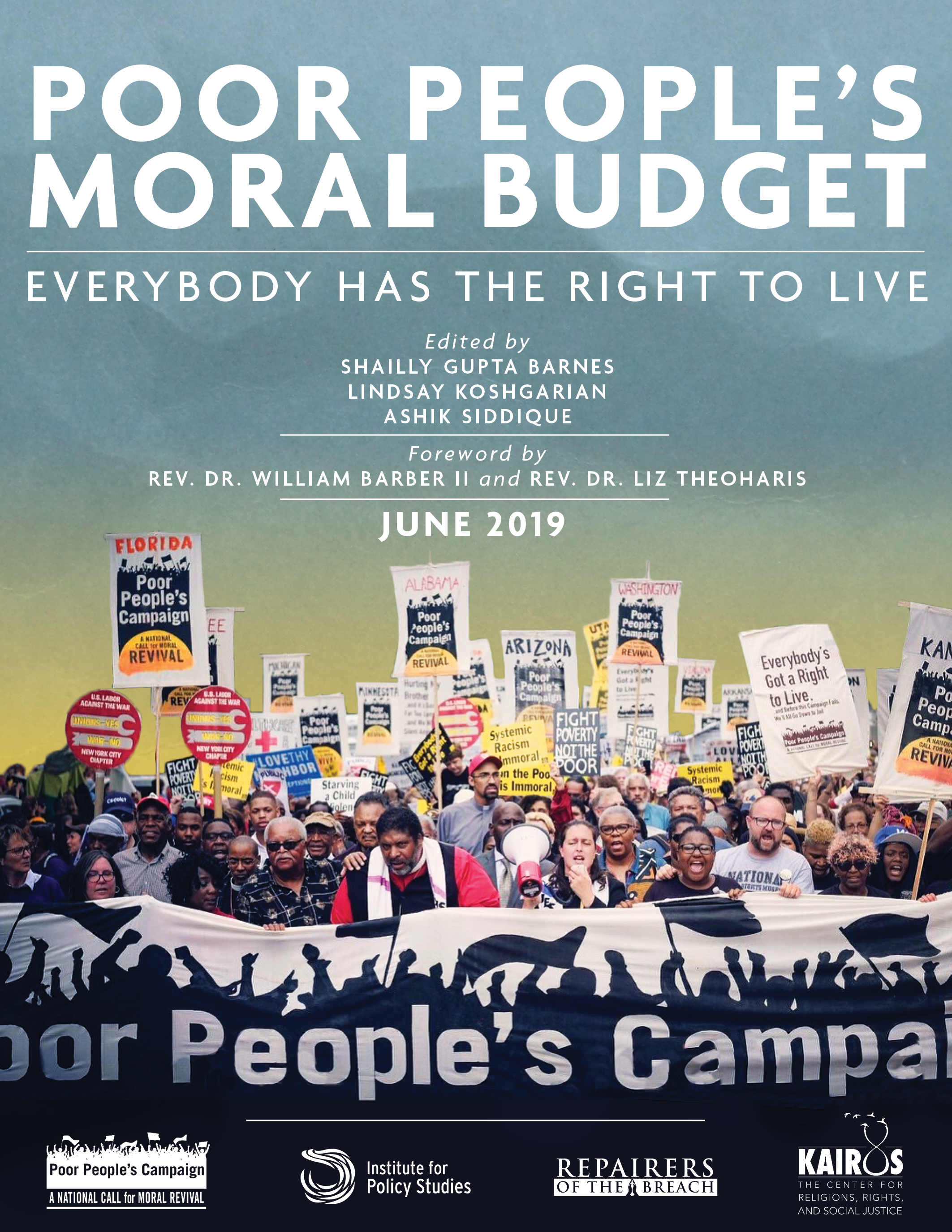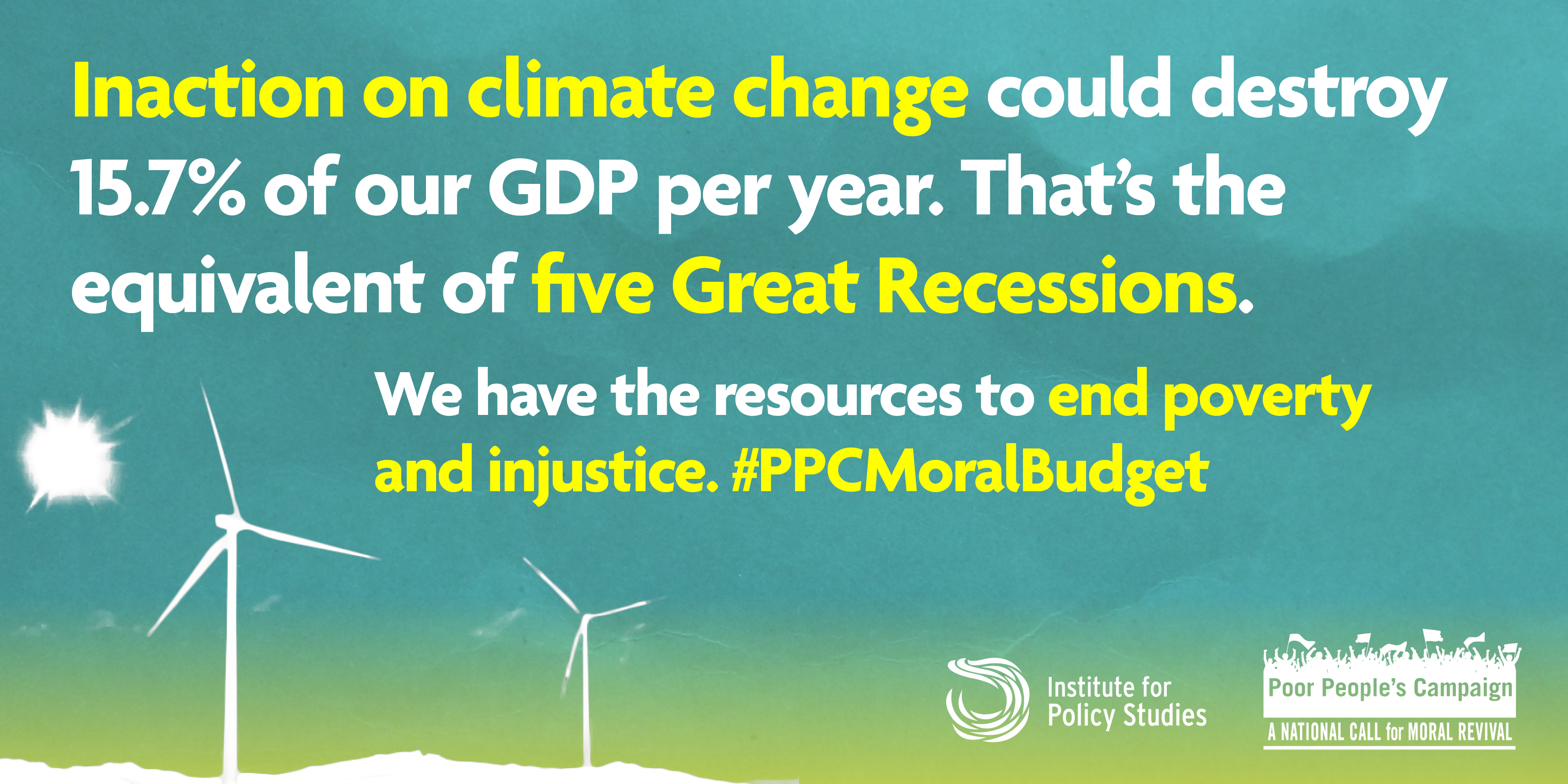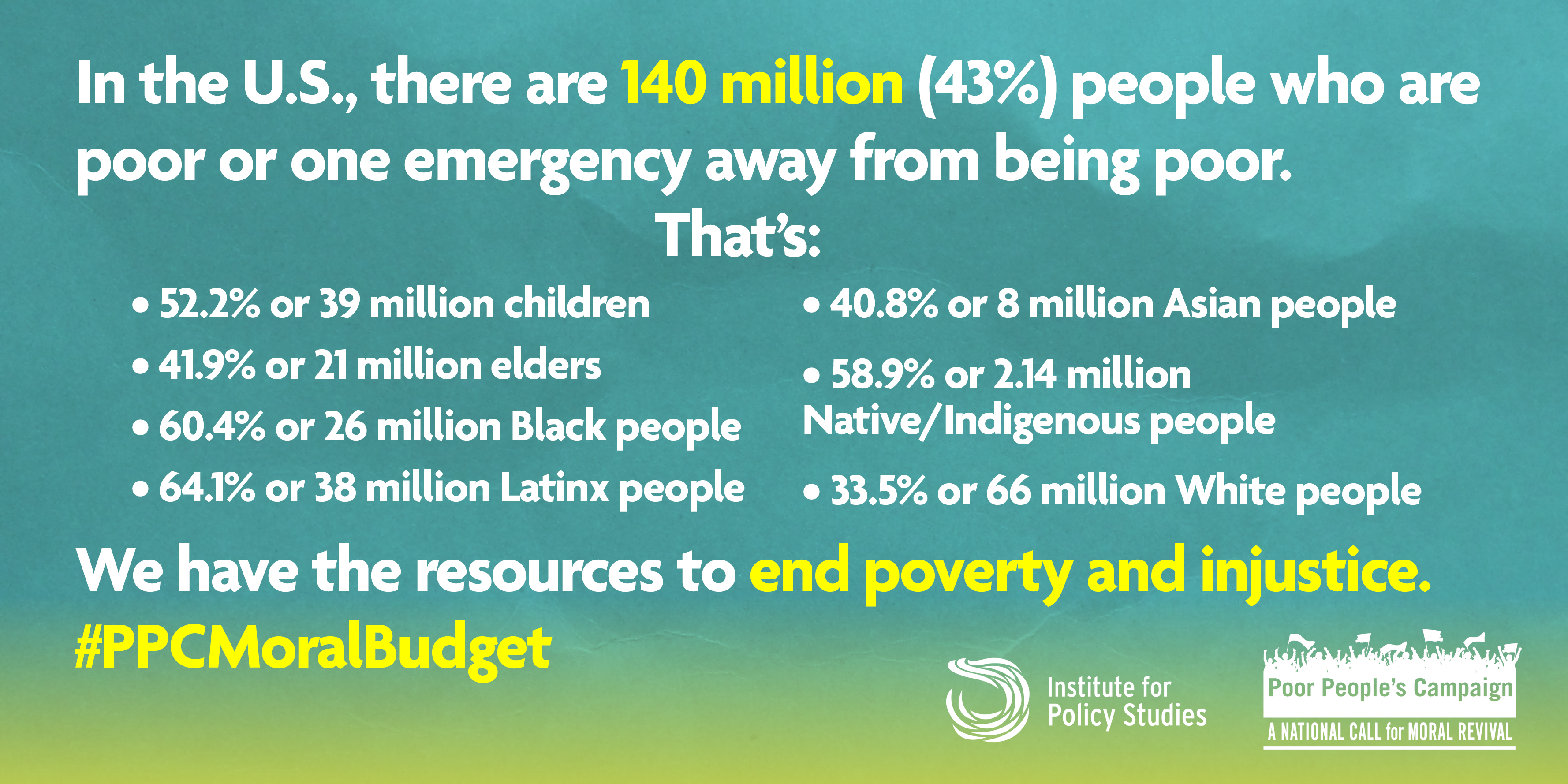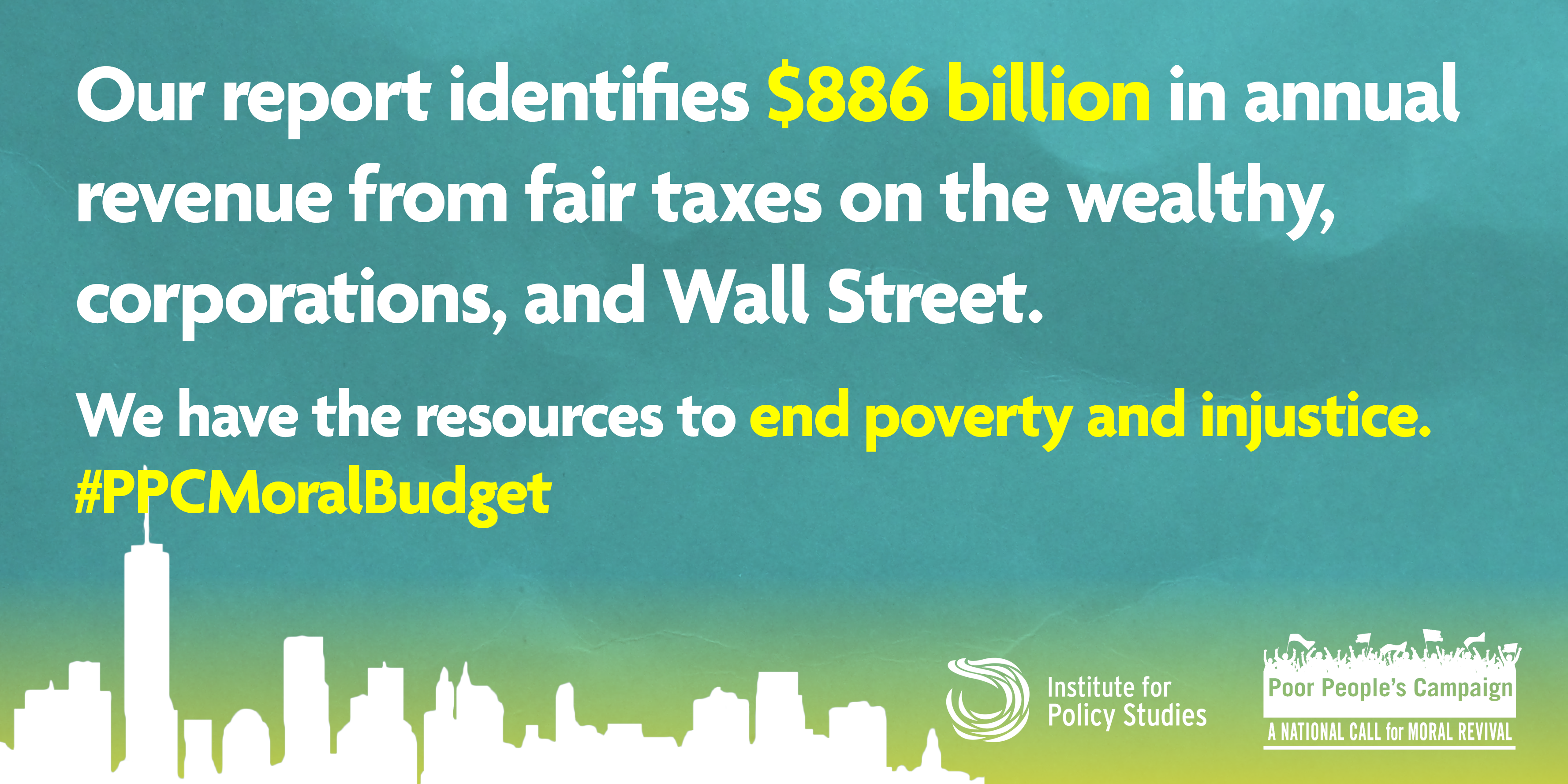Poor People’s Moral Budget: Everybody Has the Right to Live
Shailly Gupta Barnes | Lindsay Koshgarian | Ashik Siddique
Introduction:
In April 2018, the Poor People’s Campaign: A National Call for Moral Revival released a Moral Agenda and Declaration of Fundamental Rights. The demands contained within that document present a comprehensive response to the systemic racism, poverty, ecological devastation, militarism, and war economy plaguing our country today. For the 140 million people who are poor, or one emergency away from being poor, we know these demands are necessary. This Poor People’s Moral Budget asks, given the resources of our society, whether these demands are also possible. Our answer is a resounding yes.
In the seven sections of the Moral Budget, we look at policies and investments for seven critical areas of the Poor People’s Moral Agenda: 1) democracy and equal protection under the law; 2) domestic tranquility; 3) peace and the common defense; 4) life and health; 5) the planet; 6) our future; and 7) an equitable economy. In each case, we’ve found that our nation has abundant resources to meet the demands of the poor, and to address the widespread and systemic injustices we face. In contrast, the current realities of voter suppression, low and inconsistent wages, insecure access to health care and other basic needs, wealth inequality, war, and climate change are far costlier than we have been led to believe.
This Budget shows that it is possible to invest our resources in the ways demanded by this Campaign and our moral and Constitutional values: to establish justice, domestic tranquility, security, and the general welfare for all. It shows, too, just how wasteful systemic injustice is. The abundance of our society will grow even greater when we stop investing in maintaining injustice to benefit the few, and turn instead to policies based on the needs of the many
Key Findings:
The United States has abundant resources for an economic revival that will move towards establishing
a moral economy. This report identifies:
- $350 billion in annual military spending cuts that would make the nation and the world more secure;
- $886 billion in estimated annual revenue from fair taxes on the wealthy, corporations, and Wall Street; and
- Billions more in savings from ending mass incarceration, addressing climate change, and
meeting other key campaign demands.
The below comparisons demonstrate that policymakers have always found resources for their true priorities. It is critical that policymakers redirect these resources to establish justice and to prioritize the general welfare instead. The abundant wealth of this nation is produced by millions of people, workers, and families in this country and around the world. The fruits of their labor should be devoted to securing their basic needs and creating the conditions for them to thrive.
At the same time, policymakers should not tie their hands with “pay-as-you-go” restrictions that Poor People’s Moral Budget: Everybody Has the Right to Live require every dime of new spending to be offset with expenditure cuts or new revenue, especially given the enormous long-term benefits of most of our proposals. The cost of inaction is simply too great.
In this section, we found that investments in things like enfranchising voters, protecting our elections, and reforming our immigration system are moral necessities, and would yield huge economic benefits. For example:
- Transitioning to automatic, online voter registration would cost just $150 million per year for five years. That’s less than the $173 million the top two individual political donors contributed in the 2016 election.
- There is a solid economic case for the moral imperative to expand democratic rights. For example, restricting the voting and civil rights of the formerly incarcerated has cost the state of Florida an estimated $365 million per year due to administrative and court costs and increased recidivism.
- Comprehensive immigration reform would allow millions of families to live in security — and result in a net gain for the federal budget. One immigration proposal in Congress would cost the federal government around $26 billion per year, but those costs would be more than balanced by the $46 billion per year in increased revenues from income and payroll taxes.

In this section, we found that investments in domestic tranquility such as lifting poverty wages, restoring the safety net, and guaranteed employment rebuilding our infrastructure would put trillions of dollars every year into the pockets of those who need it most. For example:
- A $15 federal minimum wage enacted immediately would raise pay for 49 million workers by a combined $328 billion per year. At $22 per hour, 83 million workers would get $1 trillion more in pay. These pay raises dwarf the $7.1 billion in “tax cut bonuses” employers gave U.S. workers in 2018.
- As an immediate measure, restoring Temporary Assistance for Needy Families (TANF) to previous funding levels would provide a modicum of relief to poor families who deserve a fully functional safety net. TANF has not been adjusted for inflation since the Clinton administration, which in 2019 puts the program $8.9 billion under its 1996 level. Restoring that $8.9 billion would cost less than the roughly $14 billion the United States spends each year on increased border patrols, deportations, and incarceration.
- An annual wealth tax on just the 75,000 richest U.S. households would generate $275 billion per year — more than enough to put 2.5 million people to work fixing our public infrastructure.
In this section, we found that investments in domestic tranquility such as lifting poverty wages, restoring the safety net, and guaranteed employment rebuilding our infrastructure would put trillions of dollars every year into the pockets of those who need it most. For example:
- A $15 federal minimum wage enacted immediately would raise pay for 49 million workers by a combined $328 billion per year. At $22 per hour, 83 million workers would get $1 trillion more in pay. These pay raises dwarf the $7.1 billion in “tax cut bonuses” employers gave U.S. workers in 2018.
- As an immediate measure, restoring Temporary Assistance for Needy Families (TANF) to previous funding levels would provide a modicum of relief to poor families who deserve a fully functional safety net. TANF has not been adjusted for inflation since the Clinton administration, which in 2019 puts the program $8.9 billion under its 1996 level. Restoring that $8.9 billion would cost less than the roughly $14 billion the United States spends each year on increased border patrols, deportations, and incarceration.
- An annual wealth tax on just the 75,000 richest U.S. households would generate $275 billion per year — more than enough to put 2.5 million people to work fixing our public infrastructure.
In this section we found that investments in fair taxes on the wealthy, corporations, and Wall Street could pay for a substantial share of the proposals in this report. For example:
- Fair taxes on the wealthy, corporations, and Wall Street could generate as much as $886 billion per year in revenue to meet urgent social and environmental needs.
- Capital gains taxes on fortunes passed on to heirs would raise an estimated $78 billion per year — approximately the estimated cost of giving every American child a modest savings account at birth that would earn interest and grow, providing a nest egg for education or to buy a home.
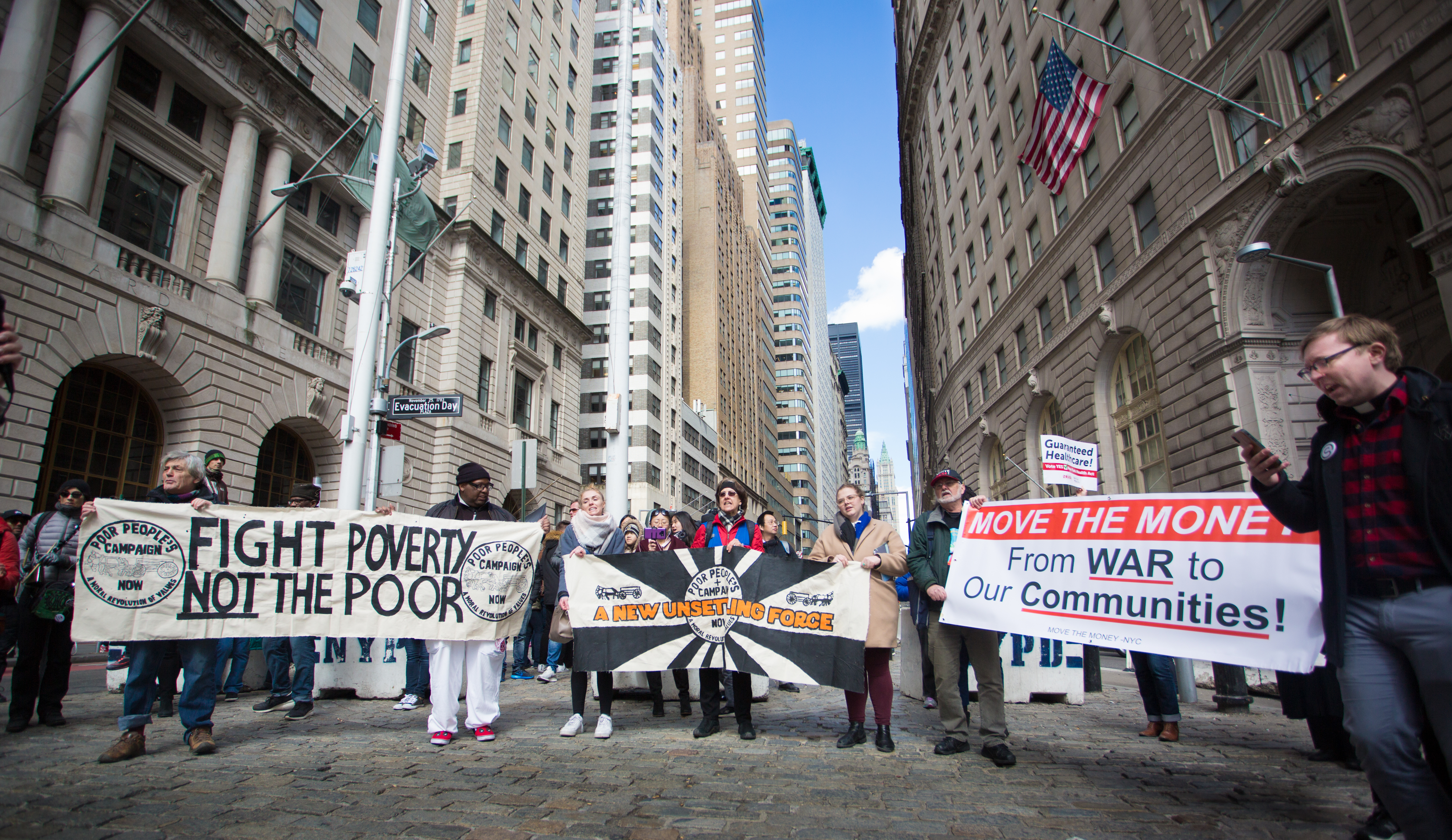
In this section we found that investments in a health system that covers everyone would actually save money. For example:
- Expanding Medicaid in the 14 states that have not yet taken advantage of Affordable Care Act subsidies for Medicaid would cost the federal government $25 billion in the first year — roughly the amount the Pentagon awards one company, Boeing, in military contracts each year.
- Even better, by eliminating bloat and negotiating better prices, a publicly funded single payer system would save money overall. One analysis estimates the savings at 9% over current costs, saving businesses and individuals as much as $310 billion per year, even as coverage is expanded to all.
- An investment of an additional $31 billion in the Indian Health Service would begin to redress the five and a half year difference in life expectancy between Native Americans and the United States average, and would cost less than half of our current spending on wars in Iraq, Afghanistan, Syria, and Yemen.
In this section we found that investments in a health system that covers everyone would actually save money. For example:
- Expanding Medicaid in the 14 states that have not yet taken advantage of Affordable Care Act subsidies for Medicaid would cost the federal government $25 billion in the first year — roughly the amount the Pentagon awards one company, Boeing, in military contracts each year.
- Even better, by eliminating bloat and negotiating better prices, a publicly funded single payer system would save money overall. One analysis estimates the savings at 9% over current costs, saving businesses and individuals as much as $310 billion per year, even as coverage is expanded to all.
- An investment of an additional $31 billion in the Indian Health Service would begin to redress the five and a half year difference in life expectancy between Native Americans and the United States average, and would cost less than half of our current spending on wars in Iraq, Afghanistan, Syria, and Yemen.
In this section we found that simply restoring pre-2018 corporate tax rates, along with a tiny tax on Wall Street trades, would easily cover childcare support, free college, and other investments we’ve failed to make in our children. For example:
- An investment of $24.4 billion per year in K-12 schools and teachers could start to boost academic performance among poor and struggling children for about the same cost as a wall at the southern border.
- Universal early learning and childcare support would require $100 billion per year. That’s substantially less than the $130 billion per year that could be generated if we merely restored the corporate tax rate to the pre-2018 level of 35%.
- For every $1 invested in early childhood education, society would gain $7.30 due to reduced poverty, lower incarceration rates, and better health outcomes.
- The federal and state shares of providing free public college would cost about $70 billion per year. That’s less than the revenue that could be generated through a tiny tax on transactions by wealthy, high-speed Wall Street traders.
- A study of public higher education in California found that for every $1 invested in public colleges and universities, the state gained $4.50 due to reduced poverty, arrests and incarcerations, and higher tax revenues.

In this section we found that investing in a clean energy transition — and in basic resource rights like clean water — would create jobs, save trillions, an address the needs of the poor and people of color who are already feeling the worst effects of climate change.
- Climate change is a cause of massive human suffering: forced migration, food insecurity, and higher rates of infection. In 2010, 400,000 deaths worldwide could already be attributed to climate change. By 2030, that number is projected to reach 700,000.
- Inaction on climate change could cost up to 15.7% of GDP per year. That’s the equivalent of wiping out $3.3 trillion from the U.S. economy — the rough equivalent of five Great Recessions, the worst economic crisis since the Great Depression.
- Addressing climate change with a $200 billion per year investment in a clean energy transition would reduce the damage to GDP while creating 2.7 million net new jobs.
- Investing $37.2 billion a year in water infrastructure would create up to 945,000 jobs while providing safe drinking water to thousands of communities that don’t have it. That’s less than what the Pentagon awarded to just one corporation — Lockheed Martin — for military contracts in 2018
In this section we found that investing in a clean energy transition — and in basic resource rights like clean water — would create jobs, save trillions, an address the needs of the poor and people of color who are already feeling the worst effects of climate change.
- Climate change is a cause of massive human suffering: forced migration, food insecurity, and higher rates of infection. In 2010, 400,000 deaths worldwide could already be attributed to climate change. By 2030, that number is projected to reach 700,000.
- Inaction on climate change could cost up to 15.7% of GDP per year. That’s the equivalent of wiping out $3.3 trillion from the U.S. economy — the rough equivalent of five Great Recessions, the worst economic crisis since the Great Depression.
- Addressing climate change with a $200 billion per year investment in a clean energy transition would reduce the damage to GDP while creating 2.7 million net new jobs.
- Investing $37.2 billion a year in water infrastructure would create up to 945,000 jobs while providing safe drinking water to thousands of communities that don’t have it. That’s less than what the Pentagon awarded to just one corporation — Lockheed Martin — for military contracts in 2018
In this section we found that shifting our foreign policy toward peace and diplomacy, and away from military-first responses, would make our world safer and put hundreds of billions back on the table for security at home. For example:
- We could save as much as $350 billion per year by cutting current Pentagon spending for fighting endless wars, maintaining a worldwide network of 800 military bases, stoking dangerous arms races, and subsidizing for-profit corporate contractors, and our military budget would still be larger than that of China, Russia, and Iran combined.
- Ending mass incarceration could drastically reduce the $179 billion per year that our nation spends on policing, courts, and private prison operators. A one-quarter reduction in spending on mass incarceration could fund $44 billion per year in investments in a housing trust fund to build, maintain, and preserve affordable rental homes.


These comparisons illustrate that we don’t lack for resources at all. The problem is that we invest our resources in priorities that fail to meet the needs of millions of people whose potential is being thwarted, whose lives are being minimized, and who are dying unnecessarily through violence and neglect. These misplaced priorities are not only damaging our social fabric, they are moving us towards a fundamentally unstable economy.
The policies presented in the Moral Budget begin to move us towards a different reality, where we can realize the full potential of our most valuable resource — the strength, genius, and creativity of our fellow human beings. Investing in these demands will fundamentally reorient our economy to be on track with our deepest moral values, and build a new foundation for prosperity for all.
There is a far better way forward, and it is within our reach.
The U.S. already has the resources we need to end poverty and injustice. How? It’s all in the #PPCMoralBudget just released by @UniteThePoor and @IPS_DC: https://ips-dc.org/report-moral-budget/ Share on Twitter
The reality: there are 140 million people in the U.S. who are poor or one emergency away from being poor. The good news: We already have the resources to end this poverty and injustice. Our new #PPCMoralBudget report with @IPS_DC shows how: https://ips-dc.org/report-moral-budget/ Share on Twitter
When 43% of the inhabitants of a country are poor or one emergency away from being poor, something has to change.
Luckily, we already have the resources to end poverty and injustice. The new #PPCMoralBudget report by @UniteThePoor and @IPS_DC shows how: https://ips-dc.org/report-moral-budget/
Share on Twitter
NEW REPORT: Our new Moral Budget with @IPS_DC shows how to combat injustice in the U.S.—from militarization to environmental racism to lack of health care—with the resources we already have.
Read and share: https://ips-dc.org/report-moral-budget/
Share on Twitter
We just released a new #PPCMoralBudget with @ips_dc to show how we can make our Moral Agenda a reality. Check it out at https://www.poorpeoplescampaign.org/budget Share on Twitter
We need to change our national priorities, and our new #PPCMoralBudget tells us how we can. Read it, share it and change the national conversation. https://www.poorpeoplescampaign.org/budget Share on Twitter
The current United States military budget is higher than at the peaks of the Vietnams or Korean wars. It is greater than at any time since World War II, with the exception of at the height of the wars in Iraq and Afghanistan. We identify as much as $350 billion in cuts that would bring the Pentagon budget down to roughly $400 billion per year, still more than the budgets of China, Russia, Iran, and North Korea – combined.
Guide to Pentagon Cuts [PDF]
The United States is in desperate need of investment for clean drinking water, sanitation, and to mitigate the effects of climate change. We calculated what those investments could look like.
Clean Water Appendix [PDF]
Clean Energy Appendix [PDF]

Download our Press Release [PDF]
Download the report Key Findings [PDF]
Media Contacts:
Robert Alvarez
robert@ips-dc.org
202-787-5205
